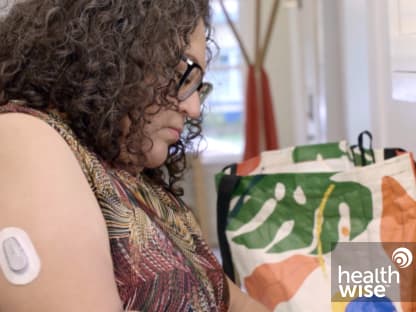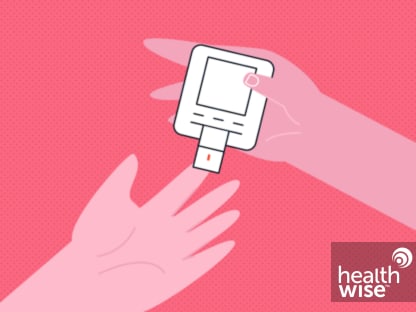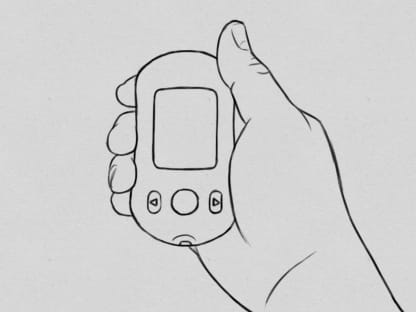Home Blood Sugar Test
Test Overview
A home blood sugar test measures the amount of a type of sugar, called glucose, in your blood at the time of testing. The test can be done at home or anywhere, using a small portable machine called a blood glucose meter. Testing blood sugar at home is often called home blood sugar monitoring or self-testing.
Home blood sugar testing can be used to monitor your blood sugar levels. Talk with your doctor about how often to check your blood sugar. How often you need to check it depends on your diabetes treatment, how well your diabetes is managed, and your overall health.
If you take insulin to manage your diabetes, you may need to check your blood sugar level often. If you use insulin rarely or don't use it at all, blood sugar testing can be very helpful in learning how your body reacts to foods, illness, stress, exercise, medicines, and other activities. Testing before and after eating can help you know how certain foods affect your blood sugar.
Some types of glucose meters can store hundreds of glucose readings. This allows you to review your glucose readings over time and to predict glucose levels at certain times of the day. It also allows you to quickly spot any major changes in your glucose levels. Some meters can save the information to your computer. This lets you see your glucose readings on a graph or in other ways that make it easier to keep track of changes. And some meters can share your results with your doctor through a smartphone app.
Some home glucose meters can communicate with or be connected to insulin pumps. An insulin pump is a tiny computer you wear that delivers insulin into your body. The meter helps to decide how much insulin you need to keep your blood sugar level in your target range.
Why It Is Done
If you have diabetes, testing your blood glucose levels at home provides information about:
- Your blood sugar level at the time of testing. It is important to know when your blood sugar is high or low, to prevent emergency situations from developing. It is also important to treat consistently high blood sugar levels so you can decrease your chances of developing heart, blood vessel, and nerve complications from diabetes.
- How much insulin to take before each meal, if you take insulin. If you take rapid-acting or short-acting insulin before meals, the blood sugar test results can help you determine how much insulin to take before each meal. If your blood sugar level is high, you may need extra insulin. If your blood sugar level is low, you may need to eat before you take any insulin.
- How exercise, diet, stress, and being ill affect your blood sugar levels. Testing your blood sugar can help you learn how your body responds to these things. You may be able to adjust your lifestyle to improve your blood sugar level.
Home blood sugar testing also may be used to:
- Decide on an initial insulin dose and schedule or to adjust the insulin doses or schedule.
- Test blood sugar levels in people who have symptoms of high blood sugar (hyperglycemia) or low blood sugar (hypoglycemia).
Watch
How To Prepare
The supplies you will need for blood sugar testing include:
- A blood glucose meter.
- Testing strips. Make sure you have test strips that will work with your meter. And check that the strips haven't expired.
- Short needles called lancets for pricking your skin. Some people use a lancet device, a pen-sized holder for the lancet. It positions the lancet and controls how deeply it goes into your skin.
- Sugar control solution. Some meters require a specific solution. Many new meters are made to be used without a control solution.
- Clean cotton balls. These are used to stop the bleeding from the testing site.
How It Is Done
Checking your blood sugar with a blood glucose meter involves pricking your skin with a lancet to collect a drop of blood. The blood drop is placed on a test strip, which you put into the meter. The instructions may be a little different for different types of meters. Follow the instructions that came with your meter.
- Wash your hands with warm, soapy water. Dry them well with a clean towel. You may also use an alcohol wipe to clean your finger or other site that you will use for the test. But make sure your hands are dry before the test.
- Select a clean lancet. Insert it into the lancet device if you use one.
- Remove a test strip from the test strip bottle. Replace the lid right away to keep moisture away from the other strips.
- Follow the instructions that came with your meter to get it ready.
- Stick the side of your fingertip with the lancet. Do not stick the tip of your finger. Some blood sugar meters use lancet devices that take the blood sample from other sites, such as the palm of the hand or the forearm. But the finger is usually the most accurate place to test blood sugar.
- Put a drop of blood on the correct spot on the test strip.
- Apply pressure with a clean cotton ball to stop the bleeding.
- Follow the directions that came with the meter to get the results.
- Write down the results and the time that you tested your blood. Some meters will store the results for you.
How long the test takes
Most meters take only a few seconds to give you the results.
Watch
How It Feels
Your fingertips may get sore from frequent pricking for blood sugar testing. But there are things you can do to prevent soreness. For example, prick the side of your finger, not the tip. Don't squeeze the tip of your finger. And use a different finger each time. You can also try a different meter that uses blood from somewhere other than the fingers.
Risks
There is very little risk of complications from testing your blood with a home blood sugar monitor.
- You may get an infection in your finger if you do not wash your hands before sticking your finger.
- You may get hardened areas on your fingertips from frequent blood sugar testing. Use lotion to help soften these areas.
Results
The American Diabetes Association (ADA) recommends that you stay within the following blood glucose level ranges. footnote 1 But depending on your health, you and your doctor may set a different range for you.
For nonpregnant adults with diabetes
- 80 milligrams per deciliter (mg/dL) to 130 mg/dL before a meal
- Less than 180 mg/dL 1 to 2 hours after a meal
For adults who have diabetes and are pregnant
- 95 mg/dL or less before breakfast
- 120 to 140 mg/dL (or lower) 1 to 2 hours after a meal
Related Information
References
Citations
Credits
Current as of: July 7, 2025
Author: Ignite Healthwise, LLC Staff
Clinical Review Board
All Ignite Healthwise, LLC education is reviewed by a team that includes physicians, nurses, advanced practitioners, registered dieticians, and other healthcare professionals.
Current as of: July 7, 2025
Author: Ignite Healthwise, LLC Staff
Clinical Review Board
All Ignite Healthwise, LLC education is reviewed by a team that includes physicians, nurses, advanced practitioners, registered dieticians, and other healthcare professionals.








